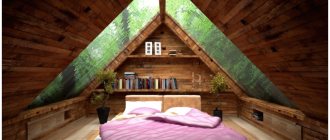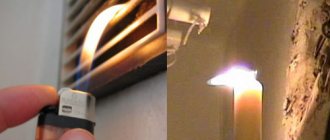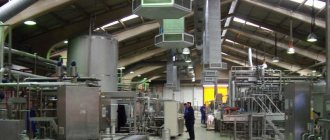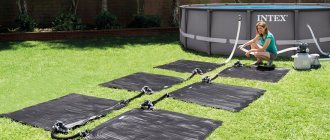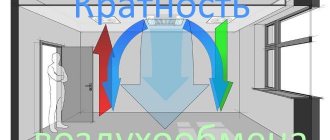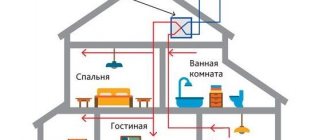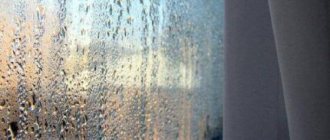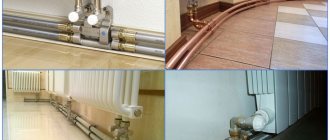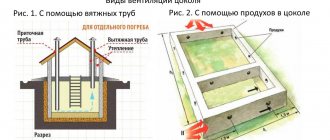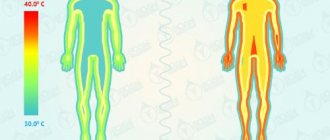Each pool is a huge container of water, which constantly evaporates and falls in the form of condensation on the ceiling, window openings or wall structures. But where there is water, there is also fungus or mold.
Moreover, exposure to increased moisture also negatively affects the durability of the pool itself, because it leads to the destruction of finishing materials and other deformation consequences. Among them :
- The appearance of rust on metal products.
- Development of fungal microorganisms.
- Swelling and destruction of plastered surfaces.
- The appearance of stains on painted parts.
- Deterioration of the insulation of conductive materials, which increases the likelihood of receiving an electric shock.
In connection with the above points, arranging ventilation for a swimming pool in a cottage is an important stage that must be taken with increased responsibility. Such equipment will save the room from various deformation processes, and will also extend the service life of the tank itself.
With good ventilation, a certain level of humidity will always be present in the interior space. This unit indicates the volume of water vapor per unit volume of air. If the humidity exceeds the permissible level, it becomes difficult to breathe in the room.
However, if the air is too dry, this also entails unpleasant phenomena. Therefore, it is important to achieve the ideal balance, guided by the operating mode of the structure, the climatic factor and the individual preferences of the owners of the room. Future calculations should be carried out taking into account air and water temperatures.
Why may pool ventilation be required?
Due to the special characteristics of the air and water in the room where the swimming pond is located, moisture safely evaporates from the bowl, and it is not possible to interfere with this process. When moisture settles on various kinds of structural elements or simply interior items, it inevitably leads to their deterioration. However, if you properly design and equip the ventilation system, it will effectively remove all air fumes to the street.
Another disadvantage of the abundance of water vapor indoors is that people who swim in the pool simply experience discomfort. Moreover, humid air negatively affects the respiratory system, as well as the psychological state of a person as a whole. And finally, the third reason why ventilation is mandatory in this case is the inevitable damage to all electronic equipment located in the pool. Typically, even ceiling lighting fixtures protected by glass become unusable.
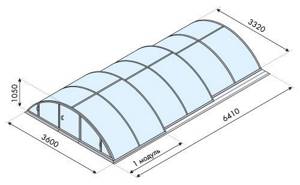
To make the ventilation system more efficient, it is usually additionally equipped with air dryers. By the way, there are many ventilation systems themselves, but only two are the most popular among them:
- with separation of outflow/inflow of air;
- supply and exhaust (with heat recovery option).
Let's take a closer look at each of the options mentioned.
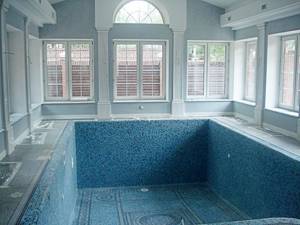
Forced
Natural ventilation is not used for rooms with high humidity due to its ineffectiveness. The most commonly used option is forced supply and exhaust ventilation, which is distinguished by its sufficient performance and the ability to use various additional equipment.
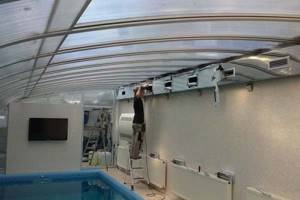
The main objective of this ventilation option is to guarantee maximum aeration. When the system is running, air masses are directed along the walls to the ceiling, ensuring air circulation at a minimum speed over the water surface of the pool and around the perimeter of the entire room. This contributes to:
- absence of moisture condensation on the ceiling and walls;
- reducing evaporation from the surface of the pool;
- increasing the comfort of swimmers.
Often, a heat recovery module is used with a pool’s supply and exhaust system, that is, the heat of the exhaust air is returned to the incoming air, which helps reduce the cost of electrical energy for heating the atmospheric air. In addition to normalizing air humidity, supply and exhaust ventilation removes unpleasant odors of dampness, giving it a feeling of freshness. Installing additional automation allows you to regulate the ventilation process in relation to the operating mode of the pool. The disadvantages of this ventilation option include the operation of the entire system in the summer, when it is not always possible to achieve standard indicators for room humidity.
Air handling unit with bypass channel
Bypass channel or recirculation from the word “compass” - circle. We simply mix the exhaust air with the supply air. Why? - This question should be asked to me by phone if you order the design of a commercial swimming pool with a water surface area of more than 80 m2.
Supply and exhaust units (separate)
In this case, we have the opportunity to take a more flexible approach to the placement of ventilation system equipment. We make separate supply and exhaust installations. They take up significantly less space than systems with a recuperator. They can be located in different rooms, for example in the attic, in the basement, and even in the suspended ceiling of the pool itself. The air supply unit, operating in 2 modes, supplies 3000 m3/h in summer, and heats and supplies only 400 m3/h in winter. The exhaust unit exhausts moist air outside, and the heating cable on the outdoor grilles protects them from the formation of icicles.
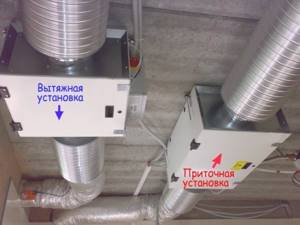
This is the simplest and most effective pool ventilation scheme. Air dehumidification is a technologically very troublesome process. The air must first be cooled, then heated. Why do we need this if the humid air can simply be thrown outside? To heat 400 m3/h of air you need only 7.5 kW of thermal energy from the boiler (not to be confused with electricity consumption) and this is at -25 oC outside.
Dehumidification and conditioning
This combination allows you to achieve maximum control over the surrounding parameters. It also guarantees permissible temperature deviations of 0.5 °C. Let's say that even without air conditioning you will feel quite comfortable.
Combined systems
Combined units perform several functions and have rather bulky equipment installed in a separate room. Such equipment is called climatic, since it maintains optimal operating conditions in an indoor home pool, regardless of weather conditions. Equipment used in combined ventilation:
- supply and exhaust fans;
- recuperator;
- Air Dryer;
- air filtration system;
- air heating equipment;
- valve system;
- automatic control unit.
A set of equipment allows you to simultaneously perform ventilation, dehumidification, heating of air in the cold season or cooling it in the summer.
Advantages of the supply and exhaust circuit
Pool owners choose a supply and exhaust system because of its many advantages.
Main advantages:
- Easy adjustment of operating parameters.
- Control is carried out from a regular remote control.
- Ability to display indicators on a computer monitor.
- There is no need to buy additional equipment for pool ventilation in winter or summer.
- Saving electrical energy due to the operation of the recuperator.
Using a supply and exhaust system, it is easy to regulate air humidity and set up a suitable microclimate.
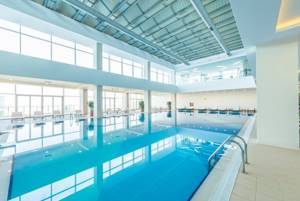
Pool ventilation requirements
In order for people to feel comfortable in the pool, the system must meet a number of requirements:
- absence of drafts where people are;
- air temperature is 2-3 degrees higher than water temperature;
- relative humidity within 50-60%.
The task comes down to designing the supply and exhaust ventilation of swimming pools in such a way as to ensure maximum air exchange in the room. This is achieved by distributing air flows along the walls and ceiling while simultaneously circulating air at a minimum speed along the perimeter and directly above the surface of the water. This air exchange scheme will allow you to avoid :
- the occurrence of condensation on the internal surfaces of the pool room
- the appearance of unpleasant sensations in people
- additional water evaporation
The volume of air supplied to the pool is smaller in volume than the volume removed. This prevents the entry of moist air from the street and the spread of odors into neighboring rooms. The optimal configuration of a supply and exhaust ventilation unit should include a heat recovery module and automation responsible for humidity control. The recuperator, by transferring part of the heat from the exhaust air to the supply air, allows the use of a less powerful heater and provides energy savings of 50-70%
You can also install a dehumidifier in your pool to better control the humidity. It can be stationary or mobile. One of the features of dehumidifiers is the release of some heat during operation. And in winter, this can be useful and will provide an additional reduction in electricity consumption.
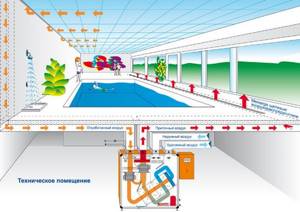
Room temperature
This parameter can be maintained through the use of heating, or, again, complex ventilation equipment. If good ventilation was initially provided for the pool, then an air conditioning system can be provided to maintain the temperature. For example, use a split system, or its version - a multi-system. Another interesting option is a cassette air conditioner. How are these types of equipment different?
As a rule, all such systems work to heat and cool air. But only a cassette air conditioner can filter air. There are even models with a ventilation function. But these types of equipment do not maintain humidity levels, with the exception of some models of cassette air conditioners.
Again, our company’s climate systems will relieve you of the need to solve individual problems, offering in return a comprehensive air preparation scheme for the pool.
A series of compact supply ventilation units CAPSULE, in which the air is cleaned and heated, and only after that it enters the room. Exhaust air is either removed through natural ventilation or forced through an exhaust hood.
It should be noted the features of installation of ventilation and air conditioning systems. The air flow should not be directed directly onto the water. This will be fraught with the appearance of additional evaporation, and, accordingly, an increase in humidity.
Water temperature
To heat water, either a separate autonomous heating system is used, or it is connected to the general heating network of the cottage. The boiler power is calculated by specialists. Heating water creates increased condensation. Therefore, when the pool is not in use, the water surface should be covered with film. This will significantly reduce heat loss in general, as well as financial costs.
Pool air conditioners
This is the embodiment of the latest technologies that allow you to purchase equipment for pool ventilation with your own hands. Air conditioners for swimming pools create the required microclimate, are fully automated and operate in the following modes:
- Space heating . The built-in heat register allows you to warm up the air in the room where the pool is located;
- Air dehumidification . The process takes place in a heat pump, where the air temperature drops to the dew point and drops of moisture are deposited on the walls of the evaporator, flowing into a container for collecting condensate. Next, the air enters the heat exchanger and is warmed before being supplied to the room;
- Fresh air intake . This function allows the air conditioner to completely replace the pool ventilation circuit, supplying heated and filtered air into the room. Warming up occurs due to heat recovery from the removed air;
- Summer mode . If the ambient air temperature exceeds the room temperature, this mode starts;
- Enhanced dehumidification . This mode is included in the ventilation scheme of a private pool if desired. It is necessary in areas with high atmospheric humidity.
The air conditioner makes ventilation in the pool easy to control and install. This is an ideal option for a country house. But there are also more powerful models for therapeutic or public pools. The technologies used allow us to minimize operating costs. The power of the fans, as well as the operation of all other components, is controlled by an electronic switch.
The air conditioner unit is protected from corrosion by polymer material and insulated.
Control is carried out by a remote control equipped with a screen, as well as an additional remote control. The screen displays information about the temperature and humidity of the room. Many models are equipped with modems that allow remote control.
Such systems allow you to very accurately maintain the microclimate in the room, ensuring high-quality ventilation of the pool. The owner can choose the appropriate equipment with his own hands.
Optimal humidity level
A comfortable level of air humidity in the pool should not exceed 65%. To reduce humidity to the optimal level, you can use a dehumidifier, forced-air ventilation, or both. Two methods are used to dry air: condensation and assimilation:
- Condensation is a method in which air is passed through a dehumidifier where its temperature reaches its dew point. After moisture condenses, the air warms up and returns to the room. In this case, thermal insulation of all air ducts is necessary to prevent condensation from draining inside the room. Often, the pool ventilation in a cottage with such an installation is equipped with a hygrostat, which starts the compressor when the humidity reaches a certain level. When the humidity drops, the compressor automatically switches off. The fan continues to work. Condensation dehumidifiers come in three types: wall-mounted, concealed, and stationary. The latter type requires a separate room or is built into the supply and exhaust system.
- The operation of supply and exhaust devices according to the principle of assimilation is based on the ability of air to absorb water vapor. The advantage of the assimilation method is that it effectively purifies the air, but there are two disadvantages. The first is related to dependence on the weather: with a high level of atmospheric humidity, the air entering the pool room does not absorb moisture. The second disadvantage is that the supply air must be heated.

Experts consider the best option for maintaining the required level of humidity in the pool room to be a combined drying method using a forced installation and a dehumidifier. However, this method is effective only for small bowl volumes, and requires careful calculation, otherwise problems may arise in resolving the issue (equipment failure, inexperienced connection of the system, etc.).
Ways to control humidity
The method of regulating and monitoring humidity indicators is to dry the entire volume of indoor air in the pool using a supply and exhaust ventilation device, installing an air dehumidifier, or a combination of these two systems.
Method #1 – Using Dehumidifiers
The problem of high humidity in the pool is partially solved by means of special dehumidifiers. The choice of this equipment is carried out according to the volume of the room. Dehumidifiers pass three times the volume of humidified air mass in the room in 1 hour of operation.
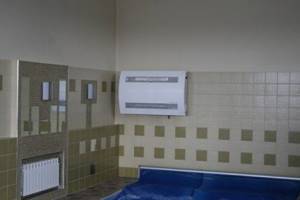
We determine the optimal relative humidity of a swimming pool in a private house to select the necessary characteristics of the dehumidifier
The selection of dehumidifiers is carried out according to the parameters required for a given facility. The action of dehumidifiers is based on the condensation of water vapor. Some models are equipped with a fresh air supply device.
Dehumidifiers are divided into types according to their purpose:
- Household. These compact units remove moisture from small areas, located on walls, floors or in a hidden way.
- Industrial. These are high-tech systems that process large volumes of air.
Depending on the installation method, the devices can be wall-mounted (floor-mounted) or duct mounted inside air ducts.
The use of wall-mounted dehumidifiers is not particularly widespread due to the noisy operation of the unit, inconsistency of design, significant cost and the need for maintenance. Duct-type dehumidifiers operate more silently, do not distort the design, but have a decent price.
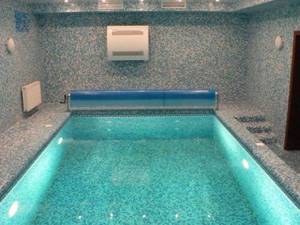
Whether a wall-mounted dehumidifier is needed in the pool or whether it is necessary to install a ducted version is chosen by the owner of the house
Basically, existing dehumidification systems do not supply fresh air into the room and do not remove waste air. It is only possible to partially solve the problem of high humidity and air exchange in the pool using dehumidification devices.
It is possible to fully ensure the required level of pool humidity by using dehumidifiers in combination with other types of ventilation.

Wall-mounted dehumidifiers can reduce indoor humidity levels, but they are not able to supply fresh air (+)
Method #2 – organizing full ventilation
The most common way to maintain optimal humidity and air quality in a pool is supply and exhaust ventilation. This system includes a ventilation unit, a network of air ducts and distribution devices.
The ventilation unit, in turn, contains elements such as an air filter, fan, heater, recuperator and automation system.
In very hot weather, air coolers and self-contained dehumidifiers are added to the system. The use of air mass recovery in a ventilation system is economically feasible, as it makes it possible to use the exhaust air to heat the supply air.
The forced ventilation system removes unpleasant odors that arise in the pool due to high humidity. Installation of a supply and exhaust system is effective when the pool area is small and not intensively used.
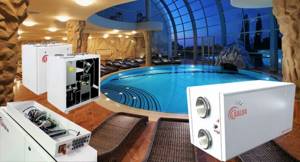
Supply and exhaust units for pool ventilation are most effective in winter (+)
This ventilation method cannot guarantee the desired level of humidity throughout the year. The system is ideal in winter, it replaces the humid air of the pool with dry air from the street.
In summer, the humidity of atmospheric air is high, so moving it through supply and exhaust ventilation into the pool does not give the desired effect.
Calculation of pool ventilation
I will analyze the calculation of ventilation using the example of a 23 m2 pool
| Swimming pool 6.9x3.4m in a cottage | Pool ventilation capacity 23 m2 depending on conditions: | ||||
| With countercurrent, underwater jets (without dryer) in Moscow | With countercurrent, underwater jets (with dryer) in Moscow | With a geyser and a fountain (without a dehumidifier) in Moscow | With countercurrent, underwater jets (without dryer) in Samara | With a geyser and a fountain (without a dehumidifier) in Samara | |
| Inflow | 1540 m3/h | 770 m3/h | 1030 m3/h | 1390 m3/h | 940 m3/h |
| Hood | 1710 m3/h | 860 m3/h | 1150 m3/h | 1550 m3/h | 1040 m3/h |
| Dehumidifier | – | 117 l/day. | – | ||
As you can see, the air volume for the same pool of 23 m2 is different for different conditions, so online calculators cannot take into account all the indicators and count with a margin. For example, a counterflow system in a swimming pool increases the size of the ventilation equipment by 33%, and installing a water slide increases the size of the ventilation equipment by 50%!
To accurately calculate your pool, I advise you to develop a ventilation project and not spare 35-45 thousand rubles. Architectural plans in DWG (AutoCAD) will be required for design.
Types of ventilation units
Today, two types of ventilation units can be used to ventilate a swimming pool:
Supply and exhaust with bypass channel;
Separate supply and exhaust.
In supply and exhaust units with a bypass duct, a circulation circuit (bypass duct) is used, in which the exhaust air can be mixed with the outside air for the purpose of drying it and additional heating. Such installations are effective for pools with a water surface area of 80 m2 or more.
The use of separate supply and exhaust units simplifies the placement of ventilation equipment. Installations can be spaced to any required distance. They can be easily placed in hidden places with easy access for maintenance and repair. A heating cable is mounted on the grille of the exhaust unit, which prevents the formation of icicles in winter.
Pool ventilation diagram
The basic principle of constructing the ventilation of an artificial font is as follows:
- exhaust air, as noted above, is removed from the upper zone;
- incoming air, having a higher temperature and low relative humidity, is directed along the perimeter of the room along the walls and windows.
This ventilation procedure makes it possible to ensure effective removal of humid air and proper maintenance of the temperature near the walls (it should be above the dew point).
IMPORTANT! If the pool is equipped with a glass roof, then part of the supply air should be supplied by a spreading jet along it and removed from the opposite side in order to ensure an increase in the temperature of the glazed surface during cold periods and cooling it in hot weather.
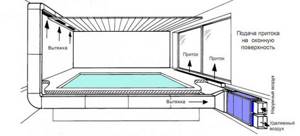
But to maintain proper humidity, it is not enough to design the ventilation correctly; you also need to determine the temperature of the water and air, which are directly related to it. For example, a decrease in air temperature by only 1 degree increases humidity by 3.5 percent .
Therefore, it is possible to reduce the humidity in the room without ventilation. To do this, you just need to cover the bowl of the reservoir with film when you are not swimming in it.
But the volume of air that enters this room must be at a level acceptable by sanitary standards. Today this figure corresponds to 80 m3/hour per person.
Ventilation elements
The main part of the system is the channels. They are made of stainless steel sheets with a thickness of 0.45-0.7 mm. They come in round and rectangular shapes. In the private sector, flattened models are installed that are distinguished by their compactness. They don't take up a lot of space, they're easy to maintain, and they're just as efficient. The following nodes are also present:
Norms and requirements
The most important thing when designing and installing a ventilation system in a swimming pool is compliance with the standards and requirements for the required temperature, humidity, and monitoring the appropriate ratio of supply and exhaust air. Therefore, there are several factors and rules:
- exhaust ventilation should be 10-15% more powerful than supply ventilation. This helps combat the occurrence of unpleasant odors, bacteria and moisture;
- the process of influx of air masses must be adjusted in such a way that each swimmer receives air in an amount of 80 m3/hour;
- The optimal humidity level for the pool should be maintained between 40% and 65%.
According to SanPiN 2.1.2.1188–03 and SNiP 2.08.02–89, the following requirements are put forward for the premises and the pool itself:
- water temperature ranges from +26°C to +29°C;
- room temperature within +27…+31°С;
- humidity at 50% to 65%;
- air exchange per person per hour – at least 80 cubic meters. m;
- mobility of air masses in the working area - no less than 0.2 m/s;
- chlorine concentration in the air – no more than 0.1 mg/cub.m.
The correct choice of location of all air distributors directly affects the efficiency of the air exchange system. Therefore, place them in such a way that air flows circulate along cold surfaces, for example, near windows. However, it is imperative to organize this system so that there are no drafts in the pool, as such, for obvious reasons.
Pool microclimate
Pool ventilation is an extremely important factor in creating a microclimate that is comfortable for humans. The lack of a high-quality ventilation system leads to the rapid spread of fungus and mold, and the accumulation of a large number of microorganisms in the air leads to the occurrence of various diseases.

High humidity in an enclosed pool area leads to corrosion of metal structures, rotting of wooden structures, and destruction of finishes and walls by fungus.
The humidity in the pool room should be at the level of 50–60%; in this case, a moderate level of moisture evaporation from the surface of the water is achieved, which affects the comfort conditions in the room. At a given humidity and air temperature of 28-30 °C (characteristic temperature for swimming pool rooms), dew will form at 16-21 °C. This is noticeably higher than for ordinary rooms, in which the air temperature is 24 °C, humidity is 50%, and the dew point is 13 °C. For swimming pool premises, excess moisture content in the air is considered normal.
Temperature and humidity for the pool
Recommended air parameters in indoor swimming pools:
- The water in the pool is within 24–28 °C.
- The air in the pool room should be 2–3 °C higher than the water temperature. When the air temperature drops, there is a risk of catching a cold. As humidity increases, you may feel stuffy. It is also not recommended to reduce the air temperature at night in order to save energy, as heat consumption increases.
- To avoid drafts, the recommended air speed should be in the range of 0.15–0.3 m/s.
All these and many other conditions are taken into account during the design, and solutions are proposed to reduce moisture condensation on the ceiling and walls. The complexity of the situation is that when people, for example, do not use the pool at night, the heat and humidity do not disappear. The pool cannot be “turned off” at night. The only way to reduce the amount of evaporation is to use water surface covers, but these devices are short-lived and rarely used.
The rate of water evaporation from the surface of the pool depending on the method of its operation
| Pool type | Empty | With bathers |
| Regular or skimmer pool | 10-20 grams/m²/hour | 130-270 grams/m²/hour |
When the humidity level reaches 80–90% at a temperature of 29–30 °C, there is a risk of exacerbation of chronic diseases and a sharp deterioration in well-being. Therefore, with a correctly calculated and designed ventilation scheme for a private pool, excess moisture is removed from the air, it is cleaned due to intensive air exchange, but does not dry out.
Air is dehumidified to the required parameters by dehumidifiers, according to moisture release parameters. Dehumidifiers can be monoblock or built into the ventilation system (with air recovery).
How does air exchange change during the cold season?
Calculating ventilation during cold weather is not much different from that carried out in the warm season.
IMPORTANT! You should know that the relative humidity in this case will be equal to 50%, and dv = 10.8 g/kg. The remaining parameters are the same as for the warm season.
Determine the amount of sensible heat:
Qi = Qosv + Qpl + Qo.d + Qv = 620 + 400 + 1440 - 480 = 1980 W.
Amount of moisture supplied:
- from swimmers Wpl is the same as in the warm season, 1340 g/h;
- from the surface of the water we find out
- from bypass paths we count
Wo.d = 6.1(27 - 19)360.45 = 790 g/h.
The total moisture supply will thus be:
W = Wpl + WB + Wod = 1.34 + 24.2 + 0.79 = 26.3 kg/h.
Next, we determine the energy of total heat:
Qsk.B = 24.2∙(2501.3 – 2.39∙25) = 59080 kJ/h;
Qsk.od = 0.79∙(2501.3 – 2.39∙31) = 1920 kJ;
Qskr.pl displays the result obtained during the warm period, that is, 3330 kJ/h.
We calculate the total amount of heat:
59080 + 1920 + 3330 + 3.6∙1980 = 71400 kJ/h.
From the data obtained we calculate the heat-moisture ratios:
How does air exchange change during the warm period?
To determine this, we take into account the heat input from:
- lighting;
- swimmers;
- bypass paths.
Solar radiation will give us heat:
Qc.p. = 2200 W.
We find out the amount of heat from swimmers in the pool as follows:
Qpl = qя ∙N∙(1 - 0.33) = 60∙10∙0.67 - 400 W (0.33 is the proportion of time that swimmers spend in the pond).
Now we determine the heat emanating from the bypass tracks:
Qi.o.d = αo.d ∙ Fo.d (to.d - tw) = 10∙36(31 - 27) = 1440 W (αo.d = 10 W/(m2/S) - heat transfer coefficient of bypass tracks ).
The heat loss that accompanies the heating of water in the bowl is determined as follows:
Qв = α∙Fв (tв - tsur) = 4∙60∙(27 - 25) = 480 W (α = 4.0 W/(m2∙°С) - heat transfer coefficient from water to air; tsur = tw - 1 °C = 26° -1° = 25°C - water surface temperature).
We recognize excess sensible heat in this way:
Qi = Qc.p. + Qpl + Qo.d - Qv = 2200 + 400 + 1440 - 480 = 3560 W.
Types of condensation dryers
As mentioned above, the condensation method involves the use of dehumidifiers. They come in different types:
- Wall-mounted – installed on walls, even on walls with finished finishing.
- Wall-mounted hidden - installation of equipment is possible only at the design stage of the building, since the equipment is hidden in the next room, which must first be prepared.
- Stationary – suitable for servicing large swimming pools, for example, in a sports complex. They are distinguished by increased power.
The choice of dehumidifier is based on the size of the room and the area of the tank.

Recuperation during pool ventilation
The recuperator is a heat exchanger made in the form of a steel box, the internal space of which is formed by channels separated by thin sheet steel. Flows of street air supplied to the premises and exhaust air removed from the premises move through these channels. As a result of the movement of counter flows, a heat exchange process occurs. Heat from the exhaust air is transferred to the air flow entering inside. It is recommended to use recuperators whose plates have a plastic coating that protects the metal from corrosion.
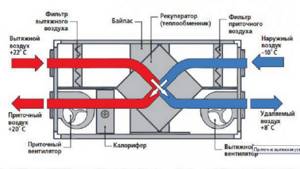
The use of a recuperator allows you to partially heat the street air that is supplied to the pool room during the cold season, due to the heat of the exhaust air. This provides significant energy savings for heating air masses. However, it must be taken into account that the use of such an installation gives the optimal effect for pools with a water surface area of at least 40 square meters. This is due to the peculiarities of the operation of the pool ventilation system, which operates in summer and winter, as well as in day and night modes.
In summer, warm and humid air is taken from the street, so additional heating is not required and the supply bypasses the recuperator. The moisture content of the air in summer reaches 12.8 g/kg or more, which requires an increase in the volume of its supply to maintain normal relative humidity in the room.
In winter, cold air is blown into the pool room, which must be preheated. Its moisture content is usually no more than 0.39 k/kg, so the volume of required supply is reduced several times. For example, for a pool with a water surface area of 25 square meters in summer, a fresh air supply of about 3000 m3/h is required. In winter, this value decreases by 7.5 times to 400 m3/h. Payback of the recuperator is ensured when pumping a volume of street air from 1000 m3/h. This supply volume in winter is necessary for pools with a water surface of at least 40 m2. In this case, the payback period will be at least 2 years.
You should think carefully and buy a pool recuperator only with plasticized plates. They will protect the recuperator from moisture. And the recuperator pays off after at least 2 years of use.
If you really want to save heat in the ventilation system, provide blinds to cover the pool water surface during non-working hours. This way you can reduce moisture release from the pool, which means reducing both the air volume and the consumption of the ventilation system by 70%.
Qualitative characteristics of the air environment
The pool ventilation system is required to maintain certain air quality parameters in accordance with the requirements of R NP ABOK 7.5-2012. The following should be supported:
- temperature;
- humidity;
- volume of fresh air intake;
- inflow-outflow ratio;
- In the climatic conditions of the middle zone it can also be used. However, in rainy and hot weather, the outside air may be too humid to prevent the method from being used.
The most effective and universal method is condensation drying on the surface of the evaporator. This method is used in dehumidifiers that are used for swimming pool ventilation equipment. The dehumidifier is a refrigeration circuit that is built into the ventilation unit. It transfers heat from the exhaust air to the supply air, thereby reducing its humidity level. An additional effect is the heating of the supply air. In summer, the refrigerant can circulate in the opposite direction, which provides cooling of the inflow.
The required volume of fresh air entering the room is established in accordance with sanitary standards. It should be at least 80 m3 per hour per person exercising in the pool. If there are spectators, each of them must have at least 20 m3 of supply air per hour. Also, when calculating the inflow during the development of a pool ventilation project, it is necessary to take into account the moisture assimilation factor. In summer, due to the smaller difference in moisture content between indoor and outdoor air, the volume of inflow should be greater than in winter.
The ratio of inflow and outlet is calculated in such a way that when the ventilation system operates in the room, a slight vacuum is created. This prevents the spread of moisture into the rooms adjacent to the pool bath area. To create such a vacuum, it is enough that the discharge exceeds the inflow by 10-15%.
The pool ventilation system must ensure constant air movement. If in residential or office premises the ventilation can be turned off for a certain time, then in a swimming pool this is unacceptable. If air movement stops, condensation immediately forms on cooled surfaces whose temperature is below the dew point. An important point when designing pool ventilation is the correct installation of air distribution devices. They should be positioned to direct airflow along cooled surfaces, such as windows. Above the surface of the water, the speed of air movement should be minimal and the formation of drafts should be avoided. This allows you to prevent intense evaporation of water from the pool and maintain comfortable conditions for swimmers.
Features of installation work
The development of a design solution for a ventilation device in a room with a swimming pool is carried out by qualified engineers, taking into account all the necessary parameters. At this stage, not only the most effective ventilation option is calculated, but its economic feasibility is also justified. It is better to make the pool ventilation system independent of the ventilation of the entire individual house or cottage.
Ventilation installation work begins during general construction work: installing channels and laying grooves. Ventilation shafts are made under the ceiling of the room and then lined with finishing materials. Air ducts are mounted from plastic or metal profile pipes made of galvanized sheet metal. The last option is used in the case of using air ducts to heat the room.
The air duct diagram is installed in such a way that it is possible to regulate the direction of air flow throughout the room evenly.
It is not advisable to place the power supply in a room with high humidity; it is better to place it in an isolated room. If there is none, you can use the space in the attic floor.
The pipeline system must have free access for annual preventive measures - cleaning of air ducts.
Features of designing private pools
Each pool in the cottage is built according to an individual project, with an individual space-planning solution, with a unique artistic design. The main requirement: maximum level of physiological and psychological comfort.
Over the past 10 years, through trial and error, the common features of a successful private swimming pool have emerged.
Typically, the swimming pool bath room is located in an attached one-story building, the only entrance to the hall leads from the house through auxiliary rooms, the area of the pool mirror is from 18 to 50 m2, the width of the walkways around the bath is from 1 to 3 m, the height of the pool is from 4 to 6 m , water heating around the perimeter of the glazing, large glazing area, glass door with access to the veranda.
The mode of use of the pool is short-term, occasional, the number of swimmers is one or two people. Screening of the water surface of the pool is increasingly being used.
The air distribution system is designed, as a rule, under the pressure of the architectural and artistic design of the ceilings and walls of the hall. It is not always possible to follow the usual recommendations:
- – humid air, as the lightest, is recommended to be removed from the upper zone;
- – the area of the ventilation grilles must be large enough to ensure the recommended air speeds;
- – it is advisable to strive to implement the principle of displacement ventilation.
In my opinion, the practice of using floor inlet grilles or wall inlet grilles in the lower zone of the pool hall in private pools did not justify itself: discomfort from air movement was too often felt, which is explained by the small size of the hall and the proximity of the ventilation grilles to the “working area.”
Installing ventilation in an indoor pool
Installing ventilation in an indoor pool requires compliance with certain rules. In particular, preparations need to be made: air exchange calculations, relative humidity of internal temperature, average moisture release time and other parameters:
- Measure the area of the room where the pool will be equipped.
- Calculate the required portion of air per person.
- Analyze the permissible number of people, that is, calculate the capacity of the pool.
- Determine the optimal room temperature.
- Measure pressure readings.
You also need to take care of the well-being of future visitors. Comfort will be ensured with the following parameters:
- 45-65% – relative humidity values;
- 2° C is the maximum difference between water and air temperatures.
In addition, the formation of drafts and strong movement of air masses should not be allowed. If you ignore this addition, visitors will become hypothermic, which will lead to colds.

Moisture condensation method
Such ventilation units for small pools are most often used in private cottages. The essence of the method is that the dehumidifier bears the main load and work. Air passes through it. The moisture turns into condensation, and the air is heated to the required temperature. Then he returns to the hall. The peculiarity of the method is that the air masses in the room are mixed with outside air.
The condensation method has a number of disadvantages:
- High energy consumption.
- Insufficient amount of fresh air.
- Increasing temperature in the room.
The advantages include ease of installation and high efficiency for small private pools.

In what cases is it necessary to install climate control systems?
Climate control systems are large-sized equipment designed to maintain an optimal microclimate throughout the year, that is, both in the cold season and in the warm period. They are installed in pools with an area of more than 100 m².
Tasks of the complexes:
- Air cleaning.
- Drying.
- Heating the air.
- Air circulation.
Components of the climate complex:
- Supply fan.
- Exhaust fan.
- Recuperator.
- Dehumidifier.
- Filters.
- Heater.
- Air valves.
- Control block
Ventilation in the apartment
A separate room next to the pool is allocated for equipment. Installation is usually carried out in the basement or adjacent utility room. The possibility of using climate control systems in each specific case must be calculated based on the size of the room.

Combined (mixed) method
The combined method is chosen for pools with high traffic and a water area of at least 50 m². There is no point in using it for private houses. Ventilation and dehumidification systems can be either independent of each other or combined into a common system. The mixed method is characterized by high installation costs, but low maintenance. It works equally effectively in both warm and cold periods.
We recommend that you read: Bathroom hood
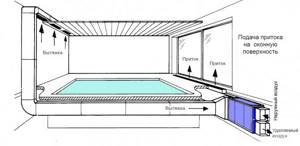
Heating of swimming pools
It is best to heat a pool with water - with convectors or radiators as heating devices. The “warm floor” has proven itself to be excellent in the pool. The advantages of a water heating system are well known - they are quiet, easy to operate, minimum space required, and relatively low cost.
If it is not possible to create water heating, for one reason or another, you can use air heating, combining it with supply and exhaust ventilation and a dehumidification system into a single heating and ventilation unit. Air heating also has its advantages - it is a high rate of room heating, temperature equalization over height, and the absence of heating devices in the room.
Useful tips and rules
In order for the design and installation of an air exhaust system to be as successful as possible, you need to take into account a lot of rules and recommendations. You should visit a special website where you can calculate the required parameters online. Planning a ventilation system will only be successful after consulting with an expert and taking into account several important points.
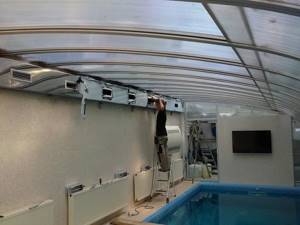
As you know, air with high humidity and high temperature is constantly directed upward, and when it collides with a cool surface it turns into condensation. In this regard, ventilation equipment can be located both in the adjacent building and under the bowl, around it or on top. In many cases, such systems are placed around the pool or on both sides of it, which causes the rapid displacement of exhaust moist air.
To ensure a comfortable microclimate in a building with a swimming pool, first of all you need to prevent the occurrence of drafts . To do this, it is enough to equalize the volumes of supply and exhaust air. In the place where visitors are located, the air should not move faster than the specified speed. Often the intensity of movements is reduced using various patterns or specific grids.
the air supply channel near the windows . It is also desirable that it be made of good heat-conducting material. Under the influence of dry air, any condensation will stop settling on the glass, and upon contact with the window, warm air will begin to cool.
Hood boxes are installed directly under the ceiling , where intense accumulation of moisture and heat is observed. Otherwise, the air will quickly escape. If there are suspended ceilings in the building, you need to think through the ventilation system in advance. If you do not do this, an area with high moisture content will appear above them.
A properly equipped air exchange system in a room with a swimming pool is the key to successful and long-term operation of such a water tank.
Therefore, in order to extend the life of the pool and protect it from premature deformation, it is important to design and install ventilation equipment in a timely manner.
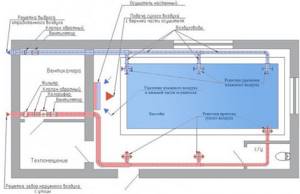
Summing up
Ventilation in the swimming pool of a private house is a complex system, the design of which requires calculation of various formulas, knowledge of the correct schemes and features of the effect of moisture on materials. Residents often order help from specialized companies, but everything can be done with their own hands. The information above will allow the reader to independently carry out all the work on creating a project for his pool, take into account all the features of his situation and prevent unnecessary expenses.
